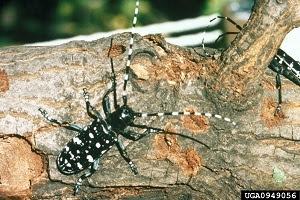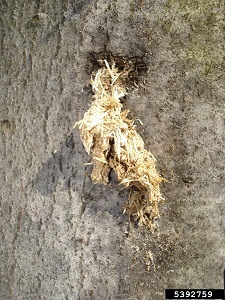Ash Borer in New York
New York State Department of Environmental Conservation Commissioner Pete Grannis announced the discovery of a well-established Emerald Ash Borer (EAB) infestation in northern Ulster County that includes land within the Catskill Park’s Forest Preserve. EAB is a small but destructive beetle that infests and kills North American ash tree species, including green, white, black and blue ash.
The discovery comes as a result of surveying efforts by DEC, the New York State Department of Agriculture and Markets (DAM) and the federal Animal and Plant Health Inspection Service (APHIS) after the initial discovery of an adult EAB specimen in Saugerties on July 15.
“This latest discovery of EAB is particularly troubling because it occurred within the boundaries of one of the state’s two constitutionally protected forest preserves,” Commissioner Grannis said. “This should be a wake-up call for everyone who enjoys New York’s forests and woodlands. We know that the transportation of firewood causes the spread of this destructive pest, so everyone should do their part to protect our trees: Don’t transport firewood. Buy your wood locally.”
Staff from DEC, APHIS and DAM have begun further investigative surveying of the initial site and the surrounding area. Evidence of EAB has since been found at a total of 19 sites spread over an area of approximately 15 square miles, encompassing the Ulster County towns of Saugerties, Ulster, Kingston, Woodstock and Hurley. Infested trees are now estimated to be in the hundreds and the center of the infestation appears to be in the vicinity of the hamlet of Ruby.
EAB has also been confirmed in two new counties. A specimen on private land in Catskill, Greene County, was confirmed this week and is likely an extension of the Ulster County infestation. The agencies confirmed the presence of EAB in a federally-deployed trap on a public right-of-way in Caledonia, Livingston County. Staff are continuing surveys to delineate the EAB presence in those and surrounding areas.
“New York State and our partners are evaluating the options available to us and learning from the experiences of other states that have battled EAB,” said Director of DEC’s Division of Lands and Forests and New York’s State Forester Robert K. Davies. “Our strategy will focus on measures that have been shown to slow the spread of EAB infestations. Meanwhile, in order to protect our forest resources, we want to re-emphasize that the public can help by complying with our restrictions on firewood movement.”
It is suspected that the spread of EAB is primarily due to the movement of infested firewood and wood products from one place to another. The recent discovery of EAB within the Catskill Forest Preserve is a reminder that many of New York State’s forests and parklands are high-risk areas due to firewood movement by campers. Identification of dead and dying ash trees, especially within popular campgrounds and parklands, may require additional measures to ensure the safety of campers and other visitors.
New York has more than 900 million ash trees, representing about 7 percent of all trees in the state.
DEC is receiving significant cooperation from the state Department of Transportation and Office of Parks Recreation and Historic Preservation and numerous other educational and not-for-profit partners. In response to the new EAB detections, DEC has also requested assistance from the state’s Forest Products Industry in restricting the movement of ash.







